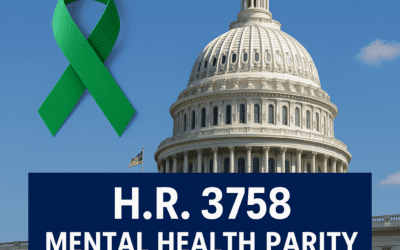In Rich v. Principal Life Ins.Co., 2007 Ill.LEXIS 1157 (Ill.S.Ct. Sept. 20), the plaintiff purchased a disability income policy in 1980 that provided benefits in the event of ”total disability,” defined as ”the complete inability of the insured due to Injury or Sickness to perform any and every duty pertaining to an occupation (as defined herein) for remuneration or profit.” The terms ”Sickness” and ”Injury” were defined as follows:
”INJURY means accidental bodily injury sustained by the Insured while this Policy is in force. Injury which is a direct or indirect result of physical or mental infirmity, illness or disease of any kind, or medical or surgical treatment therefor or Injury which results in Total Disability which commences more than 90 days after the date the Injury is sustained will be deemed to be Sickness.”
”SICKNESS means sickness or disease of the Insured first manifested while this policy is in force.”
Depending on whether the insured was disabled due to sickness or injury, benefits could be payable for the insured’s lifetime (injury) or for a five-year duration (sickness). Rich injured his right wrist at work in January 1999 and ultimately underwent surgery in May 1999 for which he submitted a claim for disability benefits after an infection incurred during the surgery resulted in permanent disability. Principal accepted the claim but advised Rich that his benefits would be limited to five years of payments because the total disability did not occur until more than 120 days after the initial accident, and that it would have to have occurred within 90 days of the accident in order to be deemed a disability due to injury.
Rich disagreed, contending that the injury causing the total disability occurred in May 1999 when he was exposed to a contaminated operating field. Principal reevaluated the claim but came to the same conclusion. Rich then submitted a report from a physician who opined that there was a causal relationship between the initial injury and the current impairment; and that the injury resulted in permanent partial disability to the right arm. However, Principal considered the report consistent with its prior findings. Principal reiterated that there was more than a 90-day gap between the injury and surgery, and that since the disability was the result of surgical treatment it constituted a sickness.
Plaintiff then brought suit for breach of contract and Principal counterclaimed for a declaratory judgment in its favor. Both parties moved for summary judgment and the trial court ruled in plaintiff’s favor. The Appellate Court reversed, finding the policy provisions clear and unambiguous. The Illinois Supreme Court affirmed the Appellate Court.
The court began its analysis by stating the general rules applicable to interpretation of insurance policies:
”When construing the language of an insurance policy, a court’s primary objective is to ascertain and give effect to the intentions of the parties as expressed by the words of the policy. Hobbs v. Hartford Insurance Co. of the Midwest, 214 Ill.2d 11, 17 (2005); Central Illinois Light, 213 Ill. 2d at 153; American States Insurance Co. v. Koloms, 177 Ill.2d 473, 479 (1997). Because the court must assume that every provision was intended to serve a purpose, an insurance policy is to be construed as a whole, giving effect to every provision (Central Illinois Light, 213 Ill. 2d at 153), and taking into account the type of insurance provided, the nature of the risks involved, and the overall purpose of the contract (Koloms, 177 Ill.2d at 479; Outboard Marine , 154 Ill.2d at 108). ‘All the provisions of the insurance contract, rather than an isolated part, should be read together to interpret it and to determine whether an ambiguity exists.’ United States Fire Insurance Co. v. Schnackenberg, 88 Ill.2d 1, 5 (1981). If the words used in the policy are clear and unambiguous, they must be given their plain, ordinary, and popular meaning (Central Illinois Light, 213 Ill.2d at 153), and the policy will be applied as written, unless it contravenes public policy (Hobbs, 214 Ill.2d at 17).”
The court noted, though, that if policy provisions are subject to more than one meaning, they will be deemed ambiguous, and any ambiguities ”will be construed strictly against the insurer who drafted the policy.”
Turning to the parties’ contentions, the court ruled that the policy’s distinction between sickness and injury is not contrary to public policy (citing 10A Couch on Insurance 3d § 146:2, at 146-10 (1998); 1 J. Appleman & J. Appleman, Insurance Law & Practice ‘§ 23, at 60 (1981)). The court cited the same authorities for the proposition that it is not against public policy for a disability insurer to require that the disability must follow within a certain number of days following an accident. The court then construed the policy:
“The policy otherwise limits plaintiff to a five-year benefit period for a disability resulting from a ‘sickness.’ The policy includes in its definition of ‘sickness’ four types of injuries. Although the punctuation used in an insurance contract cannot be manipulated to alter the plain meaning of the text, rules of grammar may be consulted to illumine the true meaning of the language used. See Continental National America Insurance Co. v. Aetna Life & Casualty Co., 186 Ill. App. 3d 891, 897 (1989); 2 Couch on Insurance 3d § 22:5 (2005). In this case, the absence of commas in the policy limitation indicates a series of restrictive clauses that identify or define the antecedent noun-injury. See W. Strunk & E. White, The Elements of Style 3-4 (3d ed. 1979) (discussing restrictive and nonrestrictive clauses). Thus the policy limitation can be separated as follows: (1) an injury which is a direct or indirect result of physical or mental infirmity; (2) an injury which is a direct or indirect result of illness, or disease of any kind; (3) an injury which is a direct or indirect result of medical or surgical treatment therefor; or (4) an injury which results in total disability which commences more than 90 days after the date the injury is sustained will be deemed to be ‘sickness.’ By deeming these four types of injury as sickness, the policy excludes them from lifetime benefits for an ‘accidental bodily injury,’ but rather limits them to five years of benefits for a sickness. This construction is consistent with a natural reading of the policy, grammar, and the nature of this type of policy. *19-*21.”
The court overruled the plaintiff’s objections by noting that the exposure to bacteria during surgery could not be deemed an accidental injury because it ignores “the causative effect” of the injury which occurred more than 90 days prior to the surgery. The court added that “the secondary results of an accident do not break the causal connection thereto.” *23. The leading insurance treatises are in accord in stating, “If *** the insured has received an injury covered by the contract which has necessitated an operation, the performance of the operation does not, in itself, constitute an independent, intervening cause nor prevent the accident from remaining the proximate cause of death [or disability].” 1B J. Appleman & J. Appleman, Insurance Law & Practice § 412, at 175-76 (1981). Also see, 10 Couch on Insurance 3d § 139:30, at 139-68 through 139-69 (1998). The court summarized with this conclusion, “In other words, where an accidental injury leads to medical complications, which in turn lead to the covered loss, the ‘accident’ is the event that caused the original injury-the ‘accident’ is not the development of medical complications. *24-*25 (citing Jurrens v. Hartford Life Insurance Co., 190 F.3d 919, 923 (8th Cir. 1999) (applying South Dakota law)). The court also found the plaintiff’s contention was undermined by its own expert who opined as to a causal relationship between the injury at work and the resulting surgery and complications.
Moreover, the court determined that if the infection that was contracted during surgery were viewed in isolation, it still falls within the definition of sickness since it occurred in the course of medical or surgical treatment. Although, in general, the unforeseen occurrence from an intended event would normally constitute an “accident” according to Christ v. Pacific Mutual Life Insurance Co., 312 Ill. 525 (1924) and United States Mutual Accident Ass’n v. Barry, 131 U.S. 100, 33 L. Ed. 60, 9 S. Ct. 755 (1889), the presence of the policy exclusion compels a different result. Under the terms of the policy, the medical or surgical treatment is deemed to fall within the provisions relating to “sickness.” The court explained that numerous policies contain similar exclusions, particularly in relation to insurance against accidental death. Although the plaintiff contended that such an interpretation would be contrary to the reasonable expectations of the insured, the court disagreed based on the plain language of the policy which was also contained in the application. The insured also had a ten day “free look” period to examine the policy after its receipt and reject the coverage if the terms and conditions were unacceptable. Since Rich retained the policy, the court found that his reasonable expectations were not frustrated by the insurer’s enforcement of the language of the policy.
This is a thoughtful ruling, but one that would have been more interesting had the court discussed a doctrine known as the “process of nature rule.” The most recent case to discuss that rule is Cranmore v. UnumProvident Corp., 430 F.Supp.2d 1143 (D.Nev. 2006), where the court explained:
“The ‘process of nature’ rule provides that “within the meaning of policy provisions requiring disability within a specified time after the accident, the onset of disability relates back to the time of the accident itself whenever the disability arises directly from the accident ‘within such time as the process of nature consumes in bringing the person affected to a state of total (disability).'” Willden v. Wash. Nat’l Ins. Co., 557 P.2d 501, 503-04 (Cal. 1976) (quoting Schilk v. Benefit Trust Life Ins. Co., 273 Cal. App. 2d 302, 307-08 (Cal. App. 1 Dist. 1969)). The process of nature rule arose out of judicial decisions interpreting policy provisions limiting benefits to injuries which are ‘immediately’ disabling. See id. (citing Frenzer v. Mut. Benefit Health & Accident Ass’n, 27 Cal. App. 2d 406 (Cal. App. 3 Dist. 1938)). In adopting the rule, courts have noted that the human body does not act on a precise timetable in responding to injuries:
“We think it may be said to be a matter of common knowledge that in a great many, perhaps in a large majority of, instances in which bodily injuries are received, the real nature and extent of said injuries do not reveal themselves until a greater or less time in the future and after the first pains from the hurt shall have passed away. The injured part often lies dormant for an indefinite period, with but little or no consciousness of its existence by the person injured, although from the very moment of the accident, perhaps, the processes of nature may be busily engaged in developing what may have seemed to be but a slight hurt into a most serious and perhaps fatal injury. In such a case it cannot be said that the injury is not continuous and from the date of the accident, nor can it fairly or justly be said that the disability is not continuous and from the date of the accident, because the injured party enjoys a brief respite from pain and suffering, only to be endured to a greater degree when perverted nature again asserts itself.
“Rathbun v. Globe Indem. Co., 184 N.W. 903, 908 (Neb. 1921).”
As a matter of public policy, it would have been sensible to apply the “process of nature rule” here. Rich’s diagnosis was not immediately apparent, which resulted in a delay in surgical treatment. Under the circumstances it seems somewhat unfair that Rich lost coverage on account of his doctors’ inability to render a definitive diagnosis and perform surgery.
With respect to the second provision, excluding from the definition of “injury” any surgical treatment, the court’s conclusion could be drawn to an absurd extreme. If the insured were injured on account of a battery performed during treatment, or if an instrument fell on the insured during surgery resulting in injury, it is doubtful that the court would have strictly applied the exclusion. Here, too, the disability did not result from surgical negligence or an unfavorable outcome of the treatment; it came about on account of an infectious agent that had nothing to do with the surgery itself. Nonetheless, the Illinois Supreme Court’s view is supported by other rulings. A fascinating case that was not cited in the Rich opinion is Senkier v. Hartford Ins.Co., 948 F.2d 1050 (7th Cir. 1991). The plaintiff in Senkier was in the hospital being treated for Crohn’s disease and suffered sudden death when a catheter that had been inserted to provide intravenous nourishment broke off and punctured the decedent’s heart. The court upheld the denial of accidental death insurance benefits, holding, “When you die from the standard complications of standard medical treatments you don’t, it seems to us, die in or because of an accident; your death is the result of illness.” 948 F.2d at 1053. Other courts have reached different outcomes, however. See, e.g., Kolb v. Paul Revere Life Insur.Co., 355 F.3d 1132 (8th Cir. 2004). Clearly, the issue is a difficult one and subject to differing viewpoints.
This article was initially published in the Chicago Daily Law Bulletin.






